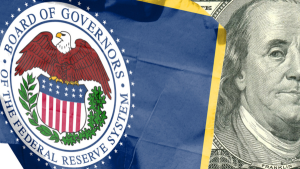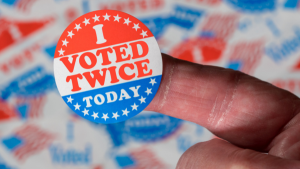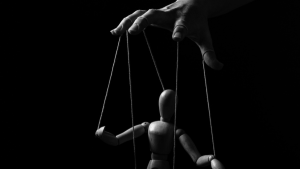Life, Liberty, Property #38: The Fed’s economic damage is far from over, with a recession yet to come. (Commentary)
IN THIS ISSUE:
- The Fed’s Economic Damage Is Far from Over
- Election Fraud Proven!
- The Truth About the Deep State
- Cartoon
SUBSCRIBE to Life, Liberty & Property (it’s free). Read previous issues.
 The Fed’s Economic Damage Is Far from Over
The Fed’s Economic Damage Is Far from Over
The Federal Reserve’s Keynesian belief that high economic growth must be crushed (lest it spark monetary inflation) pushed stock and bond markets higher at the end of last week, after the Fed announced it would continue its pause in interest rate hikes and the federal government’s monthly national jobs report showed a significant decline in hiring.
The jobs report means that the Fed is more likely to refrain from raising interest rates in the coming months, which is good news for businesses, investors, consumers, and taxpayers.
U.S. employers added barely half as many jobs in October as they added in September, well below the trendline for the previous quarter. The Wall Street Journal (WSJ) reports:
U.S. employers added 150,000 jobs in October, down from the previous month’s revised gain of 297,000, the Labor Department said Friday. That was the smallest gain since June, with automakers having around 33,000 fewer workers on payroll because of the United Auto Workers strike. The unemployment rate rose to 3.9% from 3.8% the prior month.
The unemployment rate and number of unemployed people “are up by 0.5 percentage point and 849,000, respectively,” since their recent lows in April of this year, the Labor Department’s Bureau of Labor Statistics (BLS) reports. This essentially returns the job market to its pre-pandemic condition, the BLS states. There was little change in the labor force participation rate, at 62.7 percent, and the employment-population ratio, at 60.2 percent.
Fully one-third of the new jobs were in government, however, meaning a much-higher proportion of the job growth in October was outside the private sector:
Employment in government increased by 51,000 in October and has returned to its pre-pandemic February 2020 level. Monthly job growth in government had averaged 50,000 in the prior 12 months. In October, employment continued to trend up in local government (+38,000).
That means that private-sector employment is growing even more slowly than the overall employment numbers suggest.
A variety of factors led to the decrease in job creation, including labor strikes, which accounted for all but 2,000 of the jobs lost in manufacturing. A loss of even 2,000 jobs is significant, however, given that the manufacturing sector added 17,000 jobs in September. That is a 19,000-job downturn.
In additional good news for the Fed but bad news for people who work for a living, wage growth is slowing:
Friday’s report showed wage growth cooled as employers hired less. Average hourly earnings rose 4.1% from a year ago, the department said, down from 4.3% in September. The share of people working or looking for work fell slightly to 62.7% in October from 62.8% in September.
The underlying cause of the slowdown in job creation and wage increases is obvious: “the economy is cooling,” as the WSJ put it:
The numbers point to an economy confronting higher borrowing costs following the Federal Reserve’s interest-rate increases earlier this year, as well as persistent inflation and wars in Europe and the Middle East. A downshift in job growth could ease inflation pressures, making further Fed’s rate increases less likely.
The Federal Reserve took this “cooling” as good news, as is its habit, and the stock and bond markets responded accordingly. The WSJ reports,
A downshift in job growth could ease inflation pressures, making further [Fed] rate increases less likely. … U.S. stock futures rose and Treasury yields fell. Investors were hoping for an easing of job gains as a sign that the economy is slowing and the Fed can stop tightening.
The stock and bond markets were essentially reacting to the implication—confirmation of expectations, really—that the central bank would keep the Fed funds rate where it is at present, a 22-year high, and not push interest rates up further. Investors were thanking the Fed for a very small favor. The Fed has been tightening the money supply anyway, by selling securities.
The security sales will continue, though more slowly and with an end in sight, the Fed stated on Wednesday. The Wall Street Journal reports,
The first big news Wednesday was the Treasury’s announcement that it would issue $2 billion less in long-dated bonds than expected, and stop expanding issuance after March, earlier than thought. The prospect of less bond supply than the market was prepared for lowered yields by reducing the so-called term premium, the extra yield investors demand above the future path of interest rates to hold bonds.
Much of the rapid rise in yields since the summer has been due to a rise in the term premium, although different methods of estimating it disagree on just how much. The rest of the yield increase came from the market coming to believe the Fed’s plan to keep rates higher for longer.
As a result, “Ten-year Treasury yields posted their third-biggest daily drop since March, when Silicon Valley Bank failed … knocking 0.05 percentage point off the yield … as their worries eased about the pace of growth, the scale of government bond issuance and how long the Fed will keep rates high,” the WSJ reports.
The result of all this monetary tightening, which has been going on since the middle of last year, will be a downturn in the production of goods and services—a recession. The WSJ reports,
The report “is another sign that the economy’s strength in the third quarter is likely to unwind in the fourth,” said Andrew Hunter, deputy chief U.S. economist at Capital Economics. “With wage growth also continuing to slow, it is increasingly hard to imagine the Fed hiking interest rates any further.”
That would be the long-expected recession that has failed to arrive thus far. True to Keynesian form, the WSJ attributes the “economy’s resilience” to demand-side factors:
Forecasters predicted 2023 would be a recession year in the U.S., as Americans faced higher borrowing costs. Instead, the economy has been solid, even picking up in recent months. Gross domestic product grew in the third quarter at the fastest rate since 2021, propelled by robust consumer spending.
One reason for the economy’s resilience has been the strong labor market, which has kept creating jobs despite higher borrowing costs and a volatile global situation with wars in Europe and the Middle East. That allowed Americans to keep up their spending.
However, much of this demand-side “strength” visible in the GDP numbers is not actual growth in the production of goods and services but a result of greater indebtedness. Government spending has increased rapidly, and it is being financed by debt. Consumers are borrowing more, with credit card debt at a record high. Thus, excess money the Fed created to finance a government spending spree from March 2020 through March 2023 has pushed up measured GDP regardless of what has been going on in the production of real goods and services.
Hence the economy has continued to grow despite the runup in interest rates, confounding many analysts’ expectations. There is a significant time lag, however, between monetary tightening and its effects on the overall economy, as the excess money in the economy continues to fuel both production and consumption while it lasts.
This is especially significant, and especially worrisome, in light of the amount of money that was pushed into the economy in 2020-2022 and has been drawn down for the past year. Writing at The Wall Street Journal, Johns Hopkins fellow John Greenwood and Johns Hopkins University Professor Steve H. Hanke note that the Fed’s actions since March of last year have tightened the M2 money supply measure by 3.9 percent, “the most extreme contraction since 1933,” the real onset of the Great Depression.
The enormous annual increase in M2 of 16.5 percent from March 2020 to March 2022 flooded the economy with money and sparked rapid price inflation. In a panic, the Fed hit the brakes hard and turned its policy around, raising interest rates unusually rapidly and selling securities to tighten the money supply further, Greenwood and Hanke note:
The first factor contributing to the contraction of the money supply is the Fed’s quantitative tightening. In June 2022, the Fed started to reduce its balance sheet by $45 billion a month. In September 2022, it doubled its monthly balance-sheet reduction to $90 billion. This balance-sheet runoff by the Fed requires the public to buy an equivalent amount of securities, reducing their deposits as they buy the bonds.
The decrease in bank deposits reduces banks’ ability to lend, thus impeding both production and consumption. Banks can dip into their reserves at the Fed, but they are reluctant to do so with the central bank paying them interest on those reserves, which is easy, risk-free money for them. “[B]asic balance-sheet accounting shows that unless commercial banks are creating enough ‘new money’ through their lending activity to offset the Fed’s balance-sheet shrinkage, quantitative tightening has a contractionary effect on the money supply,” Greenwood and Hanke note.
As a consequence, “The second factor contributing to shrinking M2 is the decreased availability of commercial bank credit—the sum of loans and bank holdings of securities,” Greenwood and Hanke write. “With the steep rise in [interest] rates, bank lending has slowed, and banks have been selling off securities. In September 2022, U.S. commercial banks held $17.36 trillion, but by September this year the total had fallen to $17.28 trillion. Within that total, bank holdings of securities have fallen nearly $600 billion over the same period.”
The Fed’s laser-like focus on current economic indicators continually causes it to err in its attempts to fine-tune the economy. Greenwood and Hanke write,
In all of this, an appreciation for time lags is critical. The Fed ignored the huge acceleration in the quantity of money and thus failed to anticipate the ensuing inflation. When inflation struck in early 2021, Fed officials tried to argue it was “transitory,” caused by supply-chain disruptions.
The Fed continues to ignore the money supply, and we now face the opposite problem. The money supply has been contracting for 18 months, and soon, after the overhanging extra money from 2020-21 has been used up, spending will plunge and inflation will fall, not simply to 2%, but below—and perhaps even into deflation in 2025.
The Fed is making a big mistake by looking at lagging indicators such as job reports and the consumer price index instead of monetary aggregates and “their credit counterparts,” as Greenwood and Hanke put it. The Fed’s governors and analysts are looking at economic effects, not their causes, and that is why the central bank always raises or lowers interest rates too late, too much, too fast, and for too long:
Monetary analysis tells a very different story than the measures the Fed follows. The first effect of a monetary contraction is higher market interest rates for a brief period. Then comes an economic slump. The economy goes into recession and inflation falls. This results in a second and more permanent effect of subpar money growth, namely lower interest rates and a weaker currency.
The massive increase in government spending and the Fed’s expansion of the money supply to cover it in 2020-2022 did immense damage to the economy. Unfortunately, much worse destruction is on the way, Greenwood and Hanke write:
Because of the sustained decline in the money supply, the economy is in real danger. So far, only the remaining excess money the Fed created between 2020 and 2021—the cumulative excess savings from the Covid handouts—has been keeping businesses hiring and consumers spending. The effects of the excess money are still giving the economy a lift, but that extra fuel is almost exhausted. When it dries up, the economy will run on fumes.
On Friday, The Wall Street Journal reported the consensus among economists is still that there is no danger: “Forecasters in a Wall Street Journal survey and at the Fed now say they see the economy avoiding a recession and gradually slowing to a pace that keeps inflation under control.”
I disagree with those forecasters and agree with Greenwood and Hanke. The greatly increased government spending and consumer borrowing are fool’s gold. They do not represent production of goods and services, only their consumption.
The tsunami of money is receding, and that will lead to contractions of investment and consumer spending alike. The only thing holding this all together at this point is government spending and the borrowing that supports it. Borrowing costs are increasing as interest rates rise, however, which means that the federal deficit is increasing without any additional increases in either discretionary or nondiscretionary government spending. The spending growth cannot be sustained, and its termination will remove the one thing that has been sustaining GDP growth, however deceptive the latter has been.
Yes, the strong labor market is a positive development and indicates some real economic growth outside of government—though not much. However, the notion that this will continue requires us to assume that employers will have the cash to hire more people even though interest rates are much higher than before.
That seems very unlikely; higher borrowing costs must reduce borrowing. Retained earnings of corporations have increased significantly above trend since 2020, yet it is unclear how long those accumulated profits can last and whether businesses will be willing to spend that money on expansion efforts. A big reason to limit one’s optimism about that is the federal budget deficit and debt, which suggest that the government will have to raise taxes or borrow even more (or both), either of which would squeeze businesses’ finances.
Recent marginal increases in the labor force participation rate are a good sign for those who see job creation as a curse, as the additional workers “would keep wage growth and inflation in check” by competing for a presumably static number of jobs, the WSJ reports. It is a mystery, however, why more people would enter the labor force when competition for positions is pushing wages down below a level that was already too low to entice them into the job market. It will not happen.
In any case, the expected lowering of wages (via this supposed competition that will never arrive) would reduce consumer demand, according to the formulation the WSJ’s “consensus” analysts are using. That would ease any upward pressure on consumer prices if demand-side thinking is accurate, but it would cut economic growth (by lowering demand, which they believe drives growth), which would in turn reduce demand even further, according to that same line of thinking.
If we follow through on these analysts’ logic, as they do not do themselves, their demand-side premises indicate a downturn is on the way. The WSJ acknowledges that possibility:
There are signs, however, that the job market could lose momentum in 2024. Both the number of new hires and the number of people who voluntarily quit their jobs trended down since the beginning of last year, while the number of layoffs has held steady, according to the Labor Department.
At that point, of course, the Fed will stomp on the monetary accelerator, cheapen the dollar, and start a new round of boom and bust.
Sources: The Wall Street Journal; Bureau of Labor Statistics; The Wall Street Journal; The Wall Street Journal
 Election Fraud Proven!
Election Fraud Proven!
The U.S. government and world media insist that all Americans must pretend to believe that all our elections are free and fair.
Connecticut Superior Court Judge William Clark does not agree. The Western Journal reports:
Superior Court Judge William Clark tossed out the results of a Sept. 12 primary in Bridgeport after video emerged showing an individual who was alleged to have been a supporter of Democratic Mayor Joe Ganim stuffing multiple ballots in an absentee ballot drop box.
Ganim defeated challenger John Gomes by 251 votes, trailing him in the in-person voting but riding the absentee ballots to victory, according to WNPR-FM in Connecticut.
“The volume of ballots so mishandled is such that it calls the result of the primary election into serious doubt and leaves the court unable to determine the legitimate result of the primary,” Clark said in his ruling.
This description matches countless reports from 2020 and 2022. Even so, the judge was alarmed by the evidence in this case:
The results, he wrote, “are shocking to the court and should be shocking to all the parties.”
Connecticut law requires that only a voter or a voter’s designee can drop a ballot in an absentee ballot collection box.
As with President Joe Biden’s student loan debt transfer executive orders, neglect of the border, and other knowingly unconstitutional actions, the Connecticut election will be held as planned, despite the proven corruption and the probable invalidity of its results: “The judge has no authority to halt an election, so voting is still set for Tuesday, according to the Hartford Courant,” the Journal reports.
Wait: Judges don’t have the authority to change election laws? When did that happen?
The election will go on, and if the challenger loses, the vote will be set aside and another election will take place.
At least one case of election fraud will ultimately be remedied.
To see how your state ranks in terms of election security, and how others compare, consult the Election Integrity Scorecard compiled by The Heritage Foundation. It is an impressively comprehensive, detailed, and well-documented analysis of election security in each of the 50 states and the District of Columbia. Then, petition your state government to improve its rating by emulating better practices from other states.
Source: The Western Journal; The Heritage Foundation
 The Truth About the Deep State
The Truth About the Deep State
In a very good op-ed at the Washington Examiner, the veteran political analyst Michael Barone—who merits great respect and admiration for his work—writes, “‘Deep State’ intrusiveness 20 years ago was intended to protect ordinary Americans against terrorists like those who perpetrated the 9/11 attacks. ‘Deep State’ intrusiveness today is more often directed at protecting ordinary Americans by regulating their own behavior and habits.”
Barone is on the right track there, but he has not got it quite right.
The Deep State intrudes continually into Americans’ lives strictly to increase and maintain its own power. It has no desire whatever to protect “ordinary Americans” from themselves or from anybody else. None at all.
Just take a look at our southern border, the murder rates in our cities, the number of drug overdoses, the sprawling homeless encampments, the city streets strewn with excrement and hypodermic needles, the incidence of teen suicide, the legalized ransacking of retail stores, the destruction of people’s purchasing power via monetary inflation and unrestrained government spending, forced impoverishment through anti-fossil-fuel mandates, the demolition of our health care system, unbounded lying and mythologizing by media outlets, the blatant corruption of election processes, incarceration of protestors for years in federal prisons without trial, indoctrination of children with perverse falsehoods, governments cancelling church services, mass murders committed by people already known to be mentally ill, colleges and universities taken over by thugs both within and outside the classrooms, years of rioting in the streets until the regime ordered the mobs to stand down as national elections approached—and the numerous other outrages we endure every day.
Our national regime cares only for its own power. It has nothing to do with the people of the United States except as a master. The regime shamelessly does the bidding of an international coalition of institutions engaging in enormous abuses indistinguishable from tyranny while openly brainwashing the public via moldy bread and disgraceful circuses. We, the people, are merely a resource to be exploited and cast aside when depleted.
The corruptness of our institutions represented in the term Deep State is far more thorough and destructive than even an analyst as brilliant as Barone acknowledges. It is quite possible that he cannot bring himself to believe it.
The truth is even worse than Barone’s formulation indicates. Deep State intrusiveness today is directed at terrorizing ordinary Americans by unleashing mass destruction and confusion by deranged people who hate them and want them gone.
Source: Washington Examiner
Cartoon

via Comically Incorrect
For more great content from Budget & Tax News.











